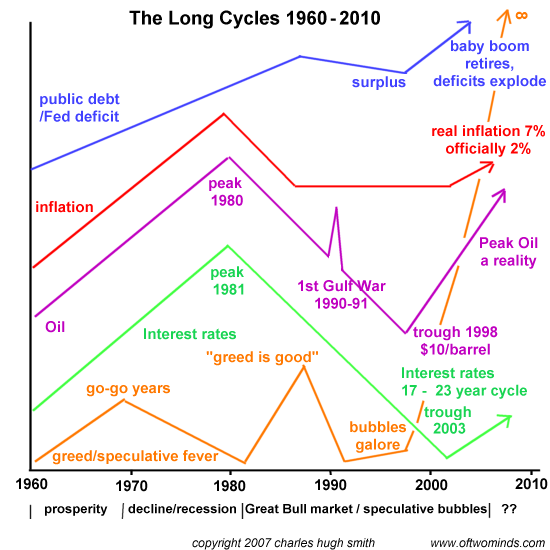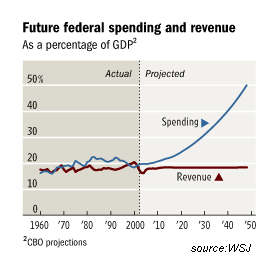

|
| weblog/wEssays archives | home | |
|
The Long Cycles of Prosperity, Decline and Upheaval (July 11, 2007) Back in April I discussed a new book by author Terence Parker titled The Rhythm of War in a civilized world. I thought so highly of Mr. Parker's insights and concise prose (the book is only 80 pages in length) that I posted a link to his site www.warcycle.com in my recommended list (right sidebar). Please note that I receive no compensation from Mr. Parker should you buy a copy of his book. The Rhythm of War sets you thinking on "long cycles" such as those posited by Russian economist Kondratieff, whose ideas I have covered in Are We Poised on the Precipice of Another Age of Turmoil? (June 2005). Kondratieff's economic cycles can be metaphorically described as the four seasons: (spring = rising prosperity, summer = false prosperity, fall = decline, winter = depression). Mr. Parker suggests the low points in the cycle might be 1789, 1849, 1896, 1934 and 1995, the latter being extremely mild. Other observers believe we are approaching a 1929-type Depression, with the cycle before that beginning in the 1870s as the immense debts and stock market frauds perpetrated during the great rush into railroads collapsed and investors/speculators were wiped out. Kondratieff's insights were based on deeply human causal factors: the way in which greed creates bubbles of speculative excess and wild risk-taking, and the manner in which the generation which recalls the hardships of Depression passes away, removing any living cultural brakes on the pell-mell rush to new speculative heights. Mr. Parker adds another cycle to our understanding, one which he describes as swings from Nationalism to Individualism which pass through intermediate periods of "self and group." He supports this supposition with fascinating graphs of suicides and workers on strike, and identifies four points in the cycle: Realization, Self-Assertion, Self-Righteousness and Disillusion. Lastly, he describes a cycle of violence, in which he identifies three general types of war: wars of domination, wars of creed, and wars of self-righteousness. Mr. Parker observes that wars of self-righteousness occur at the end of periods of rising prosperity; examples include the American Civil War, World War I and the Vietnam war. Is there a better description of the Iraqi wars than this, a war of self-righteousness occurring at the end of a long period of prosperity? From the point of view of many, it is also a war of domination as well as a war of creed. With these cycles in mind, I've drawn a little chart of various cycles which have recently reversed direction: 
Do you observe how long-term positive trends have reversed direction? 1. The Federal deficit After leveling off and actually declining in the late 90s years of Federal surplus, the deficit is approaching a staggering lift-off as baby Boomers start retiring in their tens of millions, tapping Social Security and Medicare entitlements. 
2. Interest rates After falling for 22 years, rates have been rising for 3 years, which means there's only 15-20 years more to go before they top out. 3. Inflation With money supply growing far beyond the actual economy and essentials like food, energy, healthcare and education rising by leaps and bounds, does anyone seriously doubt inflation is rising far faster than the phony official "core rate" of 2%? Note what happened last time inflation ran upward: stagflation, decline, recession, choose whatever label you prefer. 4. Oil Notice how oil (adjusted for inflation) dropped for almost two decades, with a brief spike during the first Gulf War. Now it has been on a relentless rise since 2000, with no end in sight as the realities of Peak Oil/depletion start taking effect. Note what happened last time oil rose in price: stagflation, decline, recession, etc. 5. Greed/speculative fever There were periods of speculative excess/greed in the past 50 years--the "Nifty 50"/Go-Go years of the late 60s, and the "greed is good" (as long as the taxpayer ends up with the S&L bail-out bill, hahaha) years of the 80s, but nothing like the present near-infinite rise of bubbles in global equities, bonds, real estate, derivatives, artworks, you name it. Want to get into the hot new real estate spot? Get thee to Mauritius, pronto! Hot new art field? Modern Chinese painters! Hot new furniture? Old school desks from the 60s! Yes, and you can find them right in your local school, because they're still there and in daily use! The textbooks are only 10-20 years old, so they're not yet collectable--but hey, you might be one of the first to score big if you start collecting them now. When you can barely tell parody from reality, then the speculative bubble is about to burst. Exactly what in this chart supports the idea that the boom time is set to continue for decades to come? Let's see: crushing deficits, check. Rising energy prices, check. Rising inflation, check. Rising interest rates, check. Speculative greed/bubbles are off the charts, check. When did all these conditions last occur? And what happened to the "permanent prosperity" of the 60s when they all changed course? It fell apart in a 15-year period of declining living standards, angst, stagflation and "creative destruction" of industries, livelihoods and wealth. Then all these negative trends reversed: money got cheaper every year for 20 years, oil dropped in cost for 20 years, etc. Will deficits suddenly drop away? Really? With 60 million people retiring? Will oil suddenly plummet in price, even as super-giant fields are depleted and 2 billion more people aspire to middle-class lifestyles? Will inflation suddenly decline despite massive inflation of the global money supply? Will interest rates drop even as the dollar threatens to break down? Bottom line: None of the trends essential to "permanent prosperity" have any likelihood of reversing their negative trendlines. For more on this subject and a wide array of other topics, please visit my weblog. copyright © 2007 Charles Hugh Smith. All rights reserved in all media. I would be honored if you linked this wEssay to your site, or printed a copy for your own use. |
||
| weblog/wEssays | home |